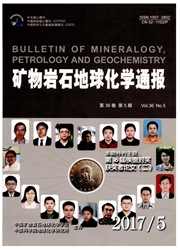

 中文摘要:
中文摘要:
新疆东部三塘湖地区处于西伯利亚板块与哈萨克斯坦板块的碰撞结合部位,属中亚造山带的重要组成部分。电子显微镜下观察和电子探针分析结果表明,三塘湖中二叠统岩浆岩主要岩石类型有苦橄岩、斑状玄武岩、粗玄玄武岩、安山玄武岩,主要造岩矿物为贵橄榄石、普通辉石、拉长石、中长石、钠长石、正长石和钾钠长石。橄榄石的Fo值为73~78,普通辉石的端元组分为Wo(40.3~44.5),En(42.5~46.9),Fs(10.2~15.7)。岩浆岩的母岩浆MgO含量在8%左右。在浅部岩浆房中,橄榄石和部分拉长石先从母岩浆中晶出,后期上涌的岩浆带着这些前期结晶相向上运移喷发,形成三塘湖岩浆岩。
 英文摘要:
英文摘要:
The Santanghu area, which locate in the collisional binding site of the Siberian plate and the Kazakhstan plate, east Xinjiang, is an important part of the Central Asian Orogenic Belt. Electron optical microscopic studies and electron probe microanalyses show that Santanghu Mid-Permian magmatic rocks have the major rock types of picrites, porphyritic basalt, holocrystalline basalt and andesitic basalt, and their main rock-forming minerals are chrysolite, augite, labradorite, feldspar, albite, orthoclase and potassium-sodium feldspar. Fo values of olivine ranges from 73 to 78. The end members of the augite are Wo (40.3--44.5), En(42.5--46.9), and Fs (10.2-- 15.7). Parent magma's MgO content is about 8% for Santanghu magmatic rocks. In the shallow magma chamber, olivine and some labradorite segregated from the parent magma, and migrated upward with these pre-crystallization during late magma upwelling and then erupted to form Santanghu magmatic rocks.
 同期刊论文项目
同期刊论文项目
 同项目期刊论文
同项目期刊论文
 期刊信息
期刊信息
